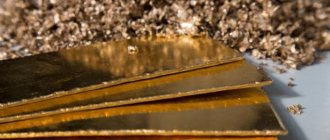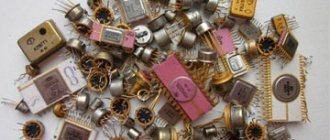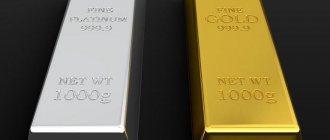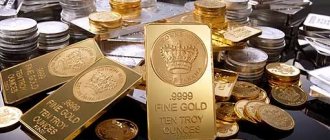The concept of “London fixing” is quite often used in analytical reviews and forecasts of precious metals markets. The procedure for valuing gold, silver, platinum and palladium, known to financiers, often turns out to be incomprehensible to a beginner who is far from world-class commodity markets. Therefore, let’s look at the essence of this procedure in more detail, find out where the historical roots of fixing come from, how the process of determining a globally significant price occurs, and what impact the London fix has on the global precious metals market.
Compulsory medical insurance quotes for precious metals: specifics of working with the account
Compulsory medical insurance reflects the price dynamics of metals in an impersonal form, shows the precious metal in grams that belongs to the client, without indicating the sample, quantity, manufacturer and other individual characteristics.
Investments in precious metals with registration on an impersonal metal account is an ideal solution, the rationale for which is the positive trend of changes in each compulsory medical insurance quote of precious metals, where operations of their attraction and placement are additionally performed.
Benefits of compulsory medical insurance:
- no VAT on purchase and sale transactions;
- absence of transport and production costs in the cost of impersonal metal;
- elimination of risks regarding loss, force majeure;
- Availability of an accessible account cashing system.
A metal account can be opened for silver, palladium, gold or platinum. Compulsory medical insurance is not included in the deposit guarantee system, so you should choose a bank that offers compulsory medical insurance services that is reliable.
Fixing history
Against the backdrop of the devaluation of the pound sterling in 1919, the Bank of England decided to grant the Rothschild Bank the right to sell South African gold. The bank had to determine the “best price” that would suit the London market and bullion sellers. The first London fixing took place on September 12, 1919 and fixed the price of gold at 4 pounds 18 shillings and 9 pence (in New York the price per troy ounce was $20.67).
We recommend reading: Gold price: start of November
The five largest gold producers and traders were participants in the fixing:
- NM Rothschild & Sons (“Rothschild and Sons”);
- Pixley & Abell (“Pixley and Abell”);
- Mocatta & Goldsmid (“Mocatta & Goldsmith”);
- Sharps Wilkins (Sharps Wilkins);
- Samuel Montagu & Co (Samuel Montagu & Co.).
In the period from 1939 to 1954, gold fixing was not carried out. This is due to the suspension of the gold market during World War II. Until 1968, gold was fixed once a day at 15:00 GMT. The timing coincided with the opening of markets in the United States.
In the entire history of gold fixing in London, the maximum was recorded on January 21, 1980 at $850 per troy ounce. Gold jumped amid a significant rise in oil prices and inflation during the unfolding crisis in the Middle East. In recent years, the maximum price for gold was recorded on August 23, 2011 at $1911.46 per troy ounce. Bringing prices into line with the inflation of past years, the peak in gold prices in the 1980s remains an all-time high.
London precious metals quotes: pricing
The London Stock Exchange is replete with global manufacturers of non-ferrous metals, large traders, and consumers. The role of reference point for world prices of precious metals is played by London quotations of precious metals - fixings, which are carried out daily.
The pricing method is traditional: five days, excluding weekends, two sessions. The exchange publishes official prices based on the results of the morning session. These are estimated prices for the execution of long-term contracts and their payment. The price for cash payments under contracts is announced individually.
The price of metals, regardless of the difference in raw material costs, is constantly linked to the exchange price. Markups and discounts are affected by demand for them.
What is gold fixing
London gold fixing (English: London gold fixing, gold fix) is a procedure for determining the price of gold on the London interbank gold market based on existing supply and demand.
Gold fixing in London is carried out on weekdays, twice a day: morning fixing (AM fix) at 10:30 and evening fixing (PM fix) at 15:00 GMT. Moscow time at 14:30 and 19:00, respectively. The price of gold under the London fixing is set in three currencies: US dollars (USD), pounds sterling (GBP) and euros (EUR) per troy ounce.
The fixing procedure was originally developed to fix and settle contracts between members of the London Bullion Market. Today, the price of gold based on the London fixing is considered the most “fair” price of gold and is used as a guide both when concluding contracts for the actual supply of gold bullion and when determining gold prices around the world.
Quotes of precious metals of the Central Bank: features of price formation
The Central Bank of the Russian Federation publishes quotes for precious metals daily. The bank sets the book value after daily fixing the prices of precious metals on the London spot market. When forming the accounting value, the Central Bank takes into account the balance of demand with supply abroad today, which is why quotations of precious metals within the Russian market do not always correspond to the official world price.
In September this year, the Bank of Russia published new prices for precious metals:
- platinum – 2014.48 rub./g;
- gold – 2426.03 rub./g;
- palladium – 1375.06 rub./g;
- silver – 31.63 rub./g.
Credit institutions need to use precious metals quotes established by the Central Bank in accounting.
Price dynamics for precious metals
On the precious metals exchange, the price constantly moves to new levels. This is due to constant jumps in both demand and supply. Representatives of many countries are trying to introduce their own trading conditions. Everyone participates with their own raw materials, as a result of which advantageous positions at a certain moment cover weaker ones.
| date | Precious metals price chart in rubles | |||
| Silver | Gold | Platinum | Palladium | |
| 01.05.16 | 36 | 2723 | 2246 | 1282 |
| 01.05.16 | 34 | 2568 | 2073 | 1115 |
| 01.07.16 | 37 | 2717 | 2071 | 1211 |
| 01.08.16 | 43 | 2860 | 2438 | 1511 |
| 01.09.16 | 39 | 2757 | 2223 | 1432 |
| 01.10.16 | 39 | 2706 | 2101 | 1465 |
| 01.11.16 | 35 | 2589 | 1989 | 1249 |
| 01.12.16 | 34 | 2490 | 1925 | 1602 |
| 01.01.17 | 31 | 2264 | 1869 | 1455 |
| 01.02.17 | 33 | 2315 | 1906 | 1448 |
| 01.03.17 | 34 | 2332 | 1911 | 1459 |
| 01.04.17 | 32 | 2234 | 1700 | 1433 |
| 01.05.17 | 31 | 2318 | 1733 | 1494 |
An interesting feature of such activities is that increased demand does not always prevail for a specific position for a long time. Once the market becomes oversaturated with one product, the price begins to decline significantly. As a result, his trading position begins to fall.
Where can I find daily online precious metals quotes?
Precious metals trading has evolved from a hedging strategy to reduce inflation risk into a winning, productive method of investing. Therefore, today banking and financial markets offer many effective, interesting investment instruments, programs for viewing online quotes of precious metals, useful information blocks, and statistical information on exchange rate dynamics.
Advice from Sravni.ru: You can also track the dynamics of any quotes using online mode on the Central Bank website. However, when opening compulsory medical insurance in a bank, it is necessary to monitor exchange rate trends exclusively in the selected credit institution on the official website.
How do trades take place?
The dynamics of prices on stock exchanges is colossal. Their movement is influenced by general world news. As a result, positive or negative forecasts are made. They put serious pressure on the cost of various positions when trading opens. Then, towards noon, the movement begins to slow down. Prices are leveling out and declines are decreasing.
There are two main indicators that control prices:
- Demotion.
- Promotion.
Some brokers play on lower prices and try to reduce the cost of the lot in order to close the deal profitably in the future by acquiring the necessary positions. The other part is trying to raise the rate by selling the volumes they have at inflated prices.
This confrontation affects the price of precious metals. The result of such actions is the total number of transactions completed during one session.
Main types of contracts and trading platforms
The London Metal Exchange makes it possible to buy and sell the following derivatives: options, futures, monthly average futures, average price options (TARO), Asian contract index (HKEX London Minis), LME Index contract (this is a stock exchange index for six major metals, including which include zinc, copper, lead, tin, nickel, aluminum), monthly 5-ton futures (LMEminis).
Each contract involves standardized conditions: the asset, all its important characteristics, volume, purity of the metal, terms and conditions of delivery are indicated. But during the bidding process, only the cost and number of contracts are determined.
Online, the London Stock Exchange provides charts of price changes for base metals, options and futures contracts.
Trading opportunities for LME participants:
- Telephone trading – conducted around the clock, outside of exchange platforms
- Ring – from 11.40 to 17.00 (local time)
- LMEselect – electronic platform, open from 1.40 to 20.00
LME structure and management
The London Non-Ferrous Metals Exchange is formed quite complexly and is the main place of trade, price formation, turnover, purchase/sale of assets.
Functions of the London Non-ferrous Metals Exchange
The exchange determines the prices of metals and products (lead, copper, nickel, aluminum, etc.) around the world. Prices are fixed in accordance with changes in the supply/demand ratio. This process brings together all traders on the exchange.
The most important representatives of the market trade here, and therefore the supply/demand balance completely shapes the current state of the market.
Hedging
The London Exchange also insures the risks of changes in value in the future - hedging operations have been carried out on the exchange since its inception and are among the reasons for the creation of the platform. Thanks to hedging, it is possible to significantly reduce future risks, which is important for traders working with financial derivatives.
Guarantee of metal supply
LME is the guarantor of the execution of all transactions in accordance with exchange contacts. The exchange has dozens of warehouses with real goods, which are located in different parts of the world.
Trading volumes are huge: aluminum is traded daily for 12 billion USD, copper for 3 billion USD, zinc for 4 billion USD, nickel for a billion, tin and lead less. Cobalt, molybdenum, cast iron, steel, and iron are also traded.
Additional features
In addition to the platform for trading non-ferrous scrap metal, the London Stock Exchange also performs simply market functions - it acts as an exchange for speculation, provides opportunities for arbitrage trading, is rightfully considered a place for the most reliable investment, allows the transfer of rights to goods temporarily with subsequent return, etc.
Types and features of trading on the LME exchange
Trading on the stock exchange is called “ring” (“ring”). It should be noted that all main operations are carried out in just 5 minutes; only 9 ring participants take part in them, sitting on chairs turned towards each other in a circle. Traders see each other, transactions are carried out by shouting (trading is usually very emotional).
Participants of the 1st category:
These companies are the most significant in the non-ferrous metals market; they have maximum rights in trading in the ring.
Between departments
This is how foreign currency or bonds are traded between different divisions of the LME. In order to find out the approximate price of currencies, participants have to contact a broker.
Online trading
Trading is conducted on our own platform for electronic work, Select Screen Trading System, where traders can analyze the state of the market in real time and make transactions.
People from all over the world can work - in Moscow, London, and New York. The main feature of online work is the availability of flexible individual settings and preferential benefits.
Trading Participants on the LME Metals Exchange
6 groups of traders take part in the trading:
- Ring Dealing Members – ring, maximum rights and opportunities.
- Associate Broker Clearing Members – traders without access to the ring.
- Associate Trade Clearing Members – there is no right to trade on the ring; trading is carried out through a clearing house on their own transactions.
- Associate Trade Members are ordinary traders.
- Individual and Honorary Members are honorary members who do not have the right to trade.
- Associate Broker Members are brokers who do not trade, but provide clients with the opportunity to work.
The London Non-Ferrous Metals Exchange is the most important in the world, setting prices for one of the main commodities on the planet. Every year, the exchange processes about 200 million lots, carries out physical deliveries of futures transactions for 4 billion tons, occupying three-quarters of the entire market.
Opening hours of the London Non-ferrous Metals Exchange
London lives and works on GMT+0 (Greenwich Mean Time), which can also be referred to as UTC+0.
In each country, time is correlated with local time. So, for example, in Moscow, GMT+3 time and the London Stock Exchange opening hours are shifted 3 hours forward. LME opens exactly at 11.40 (if in Moscow, then at 14.40) and closes at 17.00 (in Moscow it is 20.00). There are two trading sessions during this time: the first from 11.45 to 14.45 and the second from 14.55 to 17.00. The exchange's operating days are weekdays, from Monday to Friday inclusive. Weekends are traditionally Saturday and Sunday, as well as various holidays.
On the LMEselect electronic exchange you can trade online from 1.00 (in Moscow, then 4.00) until 19.00 (in Moscow, 22.00). On the telephone intra-office market (denoted as Inter-office Trading), trading is carried out 24 hours a day.
London Metal Exchange trading schedule
As was written above, the trading day on the London Non-Ferrous Metals Exchange itself is divided into 2 sessions (1st and 2nd).
Each involves 2 rings, as well as over-the-counter transactions. At the end of the ring the gong sounds. When and how trading takes place on the LME:
- 45-11.50 – first ring of the first session.
- 35-12.40 – the second ring, which fixes the metal price for the first session.
- 25-14.45 – time of over-the-counter trading.
- 55-15.00 – first ring of the second trading session.
- 10-16.15 – second ring of the second session.
- 15-17.00 – conducting over-the-counter trading of the second session of the current trading day.
There is no continuous pricing on the London Stock Exchange. Trading is carried out twice a day according to the schedule, sessions take place in a large hall where there are benches curved into a ring. Exchange members or their authorized representatives sit on them. This is the ring (or exchange ring) where deals are made. In one exchange ring, transactions are concluded for metals one by one.
Trading takes 5 minutes for each metal. After the first session, official prices for metals are announced. The afternoon session is the same as the morning one, but there are no prices after it.
Most transactions take place outside of exchange platforms - hundreds of brokers buy/sell contracts around the clock on their own responsibility. Exchange members based in other time zones are responsible for trading non-ferrous metals while the London Non-Ferrous Metals Exchange is closed.
All metal transactions are carried out in lots, the standard value of which is 25 tons. The only exceptions are tin with a lot of 5 tons and nickel with a lot of 6 tons.
History of the formation of the LME exchange
2021 marks the LME's 140th anniversary. The origins of the exchange go back to 1571, when under Queen Elizabeth I a stock exchange was opened for trading goods. The London Royal Exchange had a special interest in metals. They traded within Great Britain, but gradually the trade spread to Europe.
Important years in the formation of the London Non-Ferrous Metals Exchange:
- 1877 - The exchange officially began operations and was called the Metals and Mining Company. At first they traded copper, later they added lead and zinc (although these metals were officially included in the list only in 1920).
- 1882 - there were about 300 participants, the exchange was officially moved to a separate building (here, on Whittington Avenue, the exchange will operate for the next 98 years).
- 1897 – Silver was added to copper and tin.
- 1914 – silver trading ceased.
- 1920 – lead and zinc.
- 1935 - 1939 - work with silver was resumed for a short time.
- From World War II until 1954, the exchange did not operate.
- 1968 – 1989 – silver trading.
- 1978 – aluminum, nickel.
- 1980 – work began in the Plantation House building.
- 1989 – tin contracts.
- 1992 – aluminum alloy.
- 1994 – start of trading at the current (today’s) address.
- 2005 – contracts for plastic.
- 2010 – small contracts for cobalt and molybdenum.
- 2011 – plastic trading is closed.
- 2012 - LME bought out the HKEX holding for 1.4 billion pounds sterling, which did not affect the activities of the exchange.










